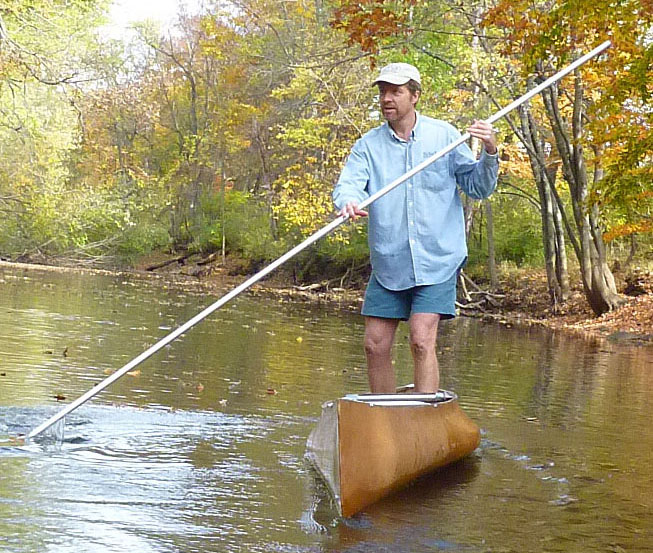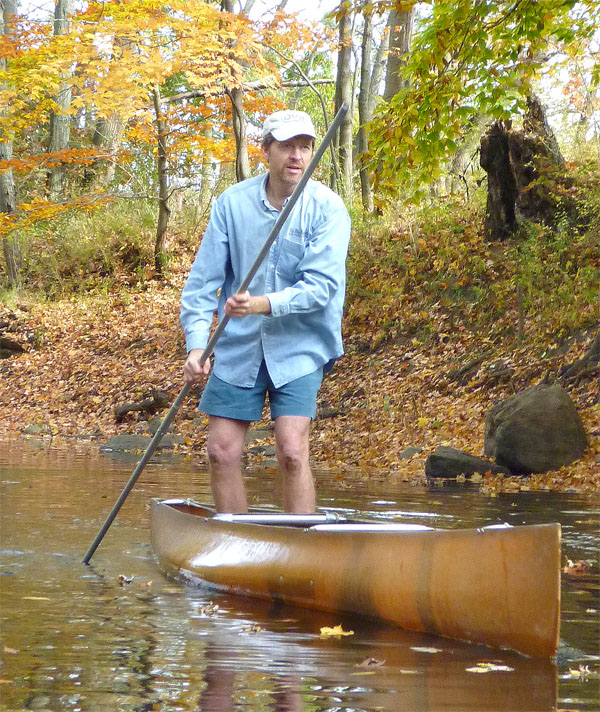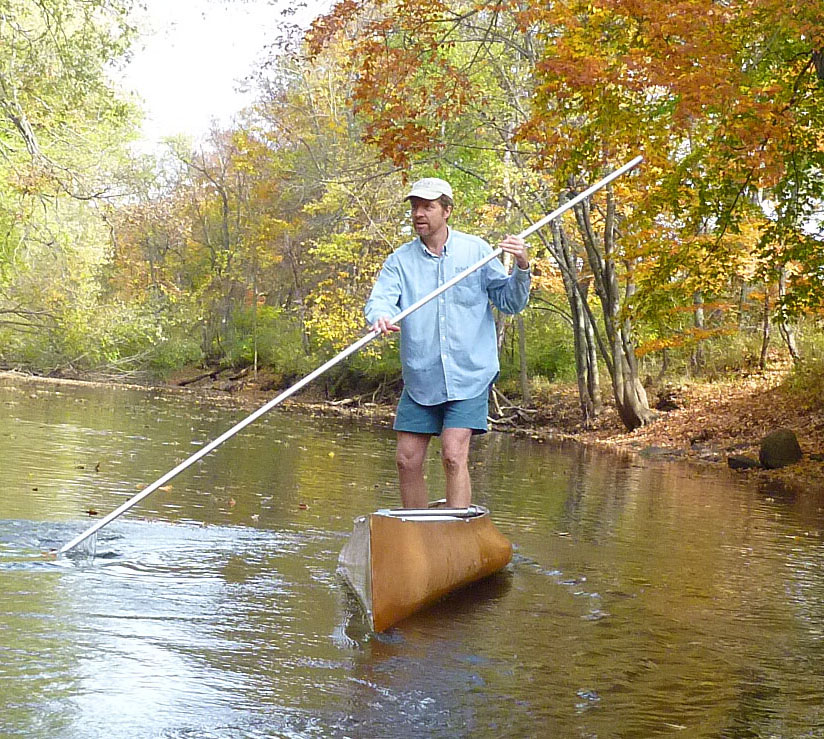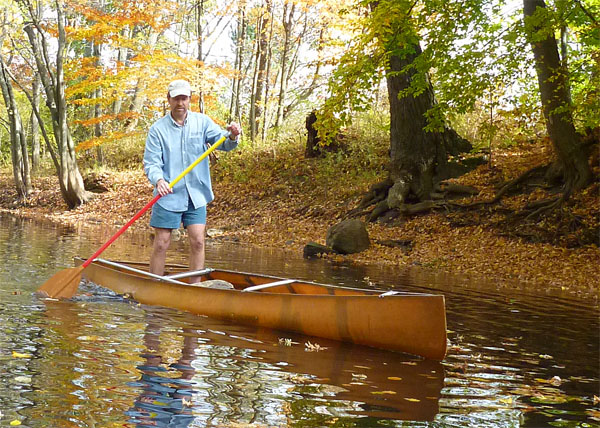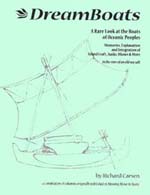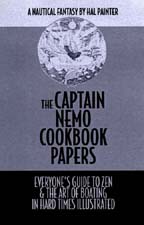Title: Canoe Pole
[$40. OUT OF STOCK Local pickup only at OYB HQ in Wmston, MI. I’ve had 2-piecers before that I can mail, for $60, with a glueable/screwable splicing plug but no such inventory right now. I need to resolve my plug situation.]
Here’s your first chance in eons to buy a real, good, canoe pole.
Oh, sometimes heavy wood or fiberglass ones are available, but here’s the real deal. At any rate it’s what you want for performance and for long distance poling in shallow waters. (The others are good for limited amounts of upstream whitewater work or muck-bottom fishing or duck-hunting.)
It’s 12 feet long. 1″ diameter. Tempered T6-6061 aluminum. One piece. Two pounds weight. (You might want to glue plugs into the ends to prevent water/mud from getting in, but with mine a pebble is wedged in there that prevents mud build-up. –Apologies to those who I told that wine-corks would fit good. I was told that they did by someone who bought one of my poles but I just tried and they don’t!)
If you try to order a pole from an aluminum source online, it’ll come in 2 6-ft pieces, with no plug, and cost at least $60.
I’ve written about canoe poling for a few years now and finally decided to make poles more available. (I see there is another pole out there now, sold to whitewater users, with a 2-piece clicker for at least $100 shipped. I’ve heard that click-button 2-piece kayak paddles always have a little wobble, so….)
[UPDATE: My 2-piece mailable pole option is not presently available! 1-piece, local pickup only!) Your pole is mailed to you in TWO 6-foot pieces with a third inner-plug piece. The plug is 12″ of T6-6061 aluminum of an outer diameter to exactly fit the inner diameter of the main parts. How you connect them all is up to you. I suggest Gorilla Glue or epoxy. Another idea, for a separable joint, might be Ferr’l’Tite Hot Melt glue, as used for gluing points to aluminum arrows — this way the pieces can be readily disassembled just by heating up the joint. (We found that clear plastic art-supply hot-melt didn’t work well — it cooled too fast.) I have pre-cleaned and abraded the parts for you, but it’s best to wash with hot soapy water before gluing then completely dry all parts.
I’ve never needed to disassemble my pole. I always just strap it onto my rack with my canoe. To carry it in the canoe I just tuck it under the thwarts. It fits easily into both solo and tandem canoes and is easy to grab out again for use.
The pole isn’t anodized so you’ll want to steelwool it from time to time to shine up any oxidization. Or wipe with lacquer.
Michigan has a lot of shallow rivers, especially in autumn when the canoeing climate can be so good (no bugs!). Many other states probably have similar water situations. But paddling shallow water is very difficult — a boat will bog down in the “suckwater.” This is where the canoe pole comes in handy and comes on strong.
As I’ve posted before, standing in a canoe is easy and fun. Poling is great all-body exercise. It’s a dynamic delight — it feels a bit like snowboarding or surfing because you use your feet to bank and move the canoe around things. It’s also a bit like XC ski skating in the V1 style. A little practice and wet feet and legs a few times is all it takes. Then you can easily enjoy the shallow waters.
(CAUTION: If you get hurt from standing in a canoe or using a pole, don’t blame me! People have done it since boats were invented but it’s not for everyone. And accidents can happen. When standing/poling I’m better off in some ways, more at risk in others. Common sense, people! Your skin is your own!)
Also, when you stand you can much more easily get out of your boat and over obstacles than when you have to get up and down from sitting.
Lastly, you can see into the water much, much better — and you can see around the river landscape much better, too.
…Wow! This is big stuff, if you think about it. When you try it, you’ll be even more impressed.
You mostly use the pole in a cartwheeling style, end over end, kind of like it’s a kayak paddle. But you can use it in many other ways as well. In deeper water you can paddle it just like a kayak paddle and get pretty good speed. Poles are also famous for making it easy to canoe upstream through rapids — this is where they get most of their fame, but, really, poles are useful for much more.
CAUTION: When learning to pole, it’s best if it’s warm out and the water is warmish and clear to the bottom and, like I said, shallow. A firm water-bottom is needed — marl won’t do. Wear a PFD. Bring spare clothes in a waterproof bag. And plan on falling in or at least stepping out a few times. If your boat is stable this may well not happen. Or it might.
When I was first learning in my old Wenonah Advantage C1 race boat I fell in quite a few times in the first few days — laughing — it was so fun. Set it up so that’s how you’ll react to getting wet. I also taped a split section of pipe-foam to the thwart behind my seat. Sometimes I press a shin against the thwart for control. You might want pie-foam over your gunnels where you stand as well. I barked my shins a couple times when doing unplanned disembarking. All that said…
A tempered aluminum pole is best for “just like paddling” performance. (Wood or fiberglass poles are heavy, slow and designed for the large forces and low-glide of whitewater.) I can pole almost as fast as I can paddle downstream — faster when going upstream. I’ve used my pole for 20 years without bending or damaging it (untempered conduit or other grades of aluminum will bend). There are no special end-plugs — an open-ended tube works great. (Your riverbed should be firm. Maybe the special duckfoot fitting is good for soft marl, but I haven’t tried one. Fishermen and duck hunters also use poles, but this isn’t like that.)
I find proper technique is to set the pole with hands somewhat raised but not overhead — maybe one hand as high as the top of your head. Elbows in. Then do an ab-crunch and drop a bit from the knees. Push and let go with the bottom hand. When you’re working with hands higher or with pole-plants farther out from the boat don’t use as much force. Our shoulder-joints are a human weak-link. Shoulders stay strong and healthy when work is done with hands *below* shoulder height and with elbows in close to chest. (I note that SUP paddling seems to involve bending at the waist which poling doesn’t — in that way the one isn’t such great training for the other. However, canoe paddling involves the same motion as poling so the cross-over effect is fairly good, except poling tempo is slower and there’s no rotation or lower-arm extension with poling.)
This is the first time since the 1980’s that a proper pole has been commercially available, as far as I know (one guy did it awhile but I’m not sure what kind of pole he sold, and he died). In the 80’s a two-piece pole was available for about $80. So this pole here is a good value.
I have a few YouTube videos showing poling and related at: youtube.com/user/OutYourBackDoor/videos.
But here’s the poling video embedded:
Here’s a direct link to the poling video: youtu.be/8uQdu9K3bRg
There have been a couple books about poling, but none are now in print, sadly. (I try to keep Harry Rock’s little how-to listed here as I can find them on the secondhand market.) I have other articles here at OYB to fill you in some more. I suppose I should try to get Harry’s book back in action, along with the great old Beletz brothers book (they made the two-piecer in the 80’s).
I also encourage folks to do standup paddling in their canoes. There’s no need to buy a standup surfboard — unless you want to surf. Surfing is great along coasts and in some whitewater playholes, but boards are largely irrelevant elsewhere. Canoes are faster and can easily carry stuff and extra people and keep it all dry. Canoes can be heavier than a board, though, but my favorite old canoe is very light at 25 lbs. So just use your long carbon paddle in a canoe!
If you already have a standup board, or are interested in one, a pole is great for them, too! A pole is great to help you learn SUP, because a pole is much more stable than a paddle. Poling is also great if you want to SUP in the shallows.
I find that I pole or standup paddle about 1/3 of the time now. Sit-down paddling is great, too, but standing is such a nice, liberating way to go. I carry all 3 tools with me when I go out on our typical shallow rivers.
Here are some pics:
